数据库操作应用场景
-
校验 测试数据
- 接口发送请求后明确会对数据库中的某个字段进行修改,但响应结果中无该字段数据时。
- 如:ihrm删除员工接口。is_delete字段,没有在响应结果中出现!需要 借助 数据库 校验!
- 接口发送请求后明确会对数据库中的某个字段进行修改,但响应结果中无该字段数据时。
-
构造 测试数据
- 测试数据使用一次就失效。
- 如:ihrm添加员工接口,使用的手机号!
- 测试前,无法保证测试数据是否存在。
- 如:ihrm查询员工接口,使用的员工id
PyMySQL操作数据库
安装PyMySQL
- 方法1:
pip install PyMySQL- 方法2:
pip install PyMySQL -i https://pypi:douban.com/simple - 测试数据使用一次就失效。
操作步骤
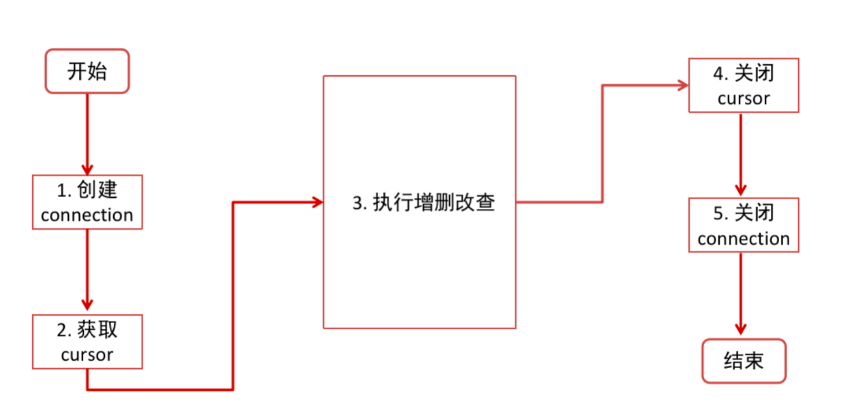
-
导包 import pymysql
-
**创建连接。**conn=pymysql.connect(host,user,password,database,charset)
-
**获取游标。**cursor=conn.suror()
-
**执行SQL。**cursor.execute(“sql语句”)
- 查询语句(select)
- 处理结果集(提取数据 fetch*)
- 增删改语句(insert、update、delete)
- 成功:提交事务 conn.commit()
- 失败:回滚事务 conn.rollback()
5.关闭游标。cursor.close()
6.**关闭连接。**conn.close()
- 查询语句(select)
事务的概念
-
事务,是关系型数据库(mysql)特有的概念。
-
事务,可以看做一个虚拟的容器,在容器中存放一系列的数据库操作,看做一个整体。内部的所有操作,要么都是一次性全部成功,只要有一个失败,就全部失败!
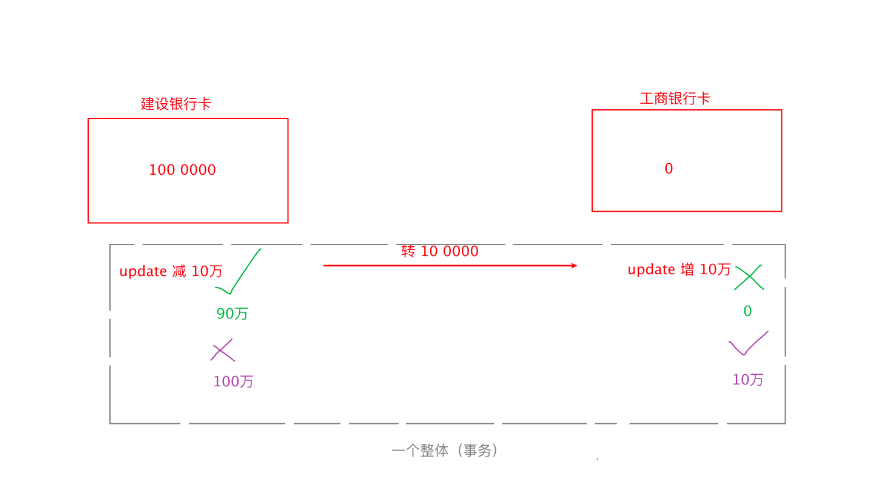
-
事务操作:只有2种情况
- 提交:conn.commit()
- 回滚:conn.rollback()
PyMySQL连接数据库
建立连接方法
conn = pymysql.connect(host=" ",port=0,user="",password="",database="",charset=" ")
host:数据库所在主机 IP地址 -string
port:数据库使用的 端口号 -int
user:连接数据库使用的 用户名 -string
database:要连接的那个数据库的名字 -string
charset:字符集。常用 utf-8 -string
conn:连接数据库的对象
入门案例
查询数据库,获取MYSQL服务器 版本信息
#1.导包
import pymysql
#2.建立连接
conn = pymysql.connect(host="localhost",port=3306,
user="root",password="root",
database="test_db",charset="utf8")
#3.获取游标
cursor=conn.cursor()
#4.执行sql语句(查询)
cursor.execute("select version()")
#5.获取结果
res=cursor.fetchone()
print("res=",res[0])
#6.关闭游标
cursor.close()
#7.关闭连接
conn.close()
PyMySQL操作数据库
SQL语法回顾
- 查询语法:
select 字段1,字段2,...from 表 where 条件;
示例:select id,title,pub_date from t_book where title='读者';
- 添加语法:
insert into 表名(字段1,字段2,...)values (值1,值2,...);
示例:insert into t_book(id,title,pub_date)values(17,'红楼梦','2021-11-11');
- 更新语法
update 表名 set 字段名=字段值 where 条件
示例:update t_book set title ='三国' where id=17;
- 删除语法:
delete from 表名 where 条件
示例:delete from t_book where title="三国";
数据库查询
查询操作流程
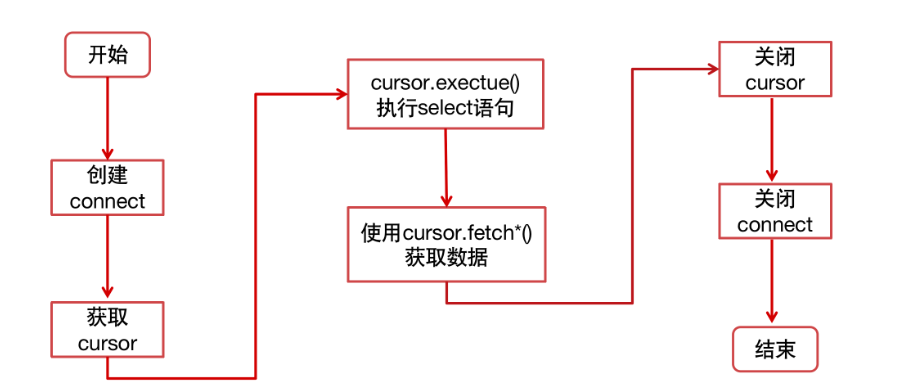
cursor游标
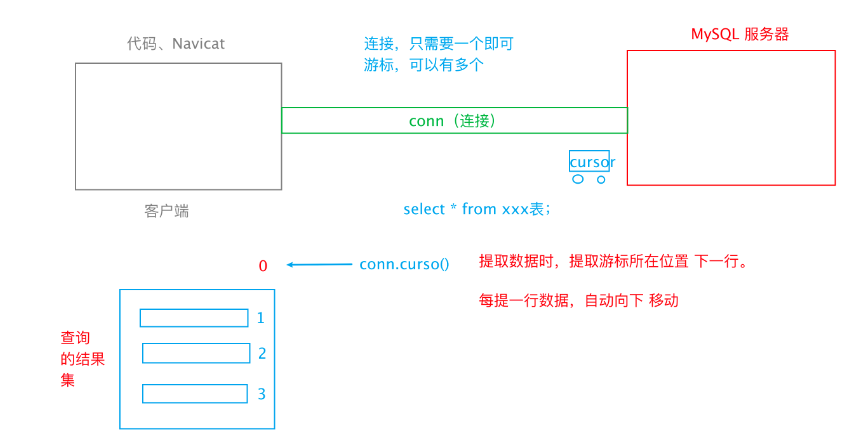
常用方法
- fetchone():从结果集中,提取第一行。
- fetchmany(size):从结果集中,提取size行。
- fetchall():提取所有结果集。
- 属性rownumber:可以设置游标位置。
案例
查询t_book表,获取 第一条 数据
查询t_book表,获取 前两条 数据
查询t_book表,获取 全部 数据
查询t_book表,获取第3条和第4条 数据
#1.导包
import pymysql
#2.建立连接
conn = pymysql.connect(host="localhost",port=3306,
user="root",password="root",
database="test_db",charset="utf8")
#3.获取游标
cursor=conn.cursor()# 指向0号位置
#4.执行sql语句(查询) ---t_book
cursor.execute("select * from t_book")
#5.获取结果 -提取第一条
res1=cursor.fetchone()
print("res1=",res1)
#修改游标位置:回零
cursor.rownumber=0
#获取结果 -提取前两条
res2 =cursor.fetchmany(2)
print("res2=",res2)
#修改游标位置:回零
cursor.rownumber=0
#获取结果 -获取全部数据
res3 =cursor.fetchall()
print("res3=",res3)
#修改游标位置:指向第2条记录
cursor.rownumber=2
#获取结果 -提取第3条和第4条
res4 =cursor.fetchmany(2)
print("res4=",res4)
#6.关闭游标
cursor.close()
#7.关闭连接
conn.close()
异常捕获
try:
尝试执行的代码
except Exception as err:
有错误出现时,执行的代码
finally:
无论有没有错误,都会执行的代码
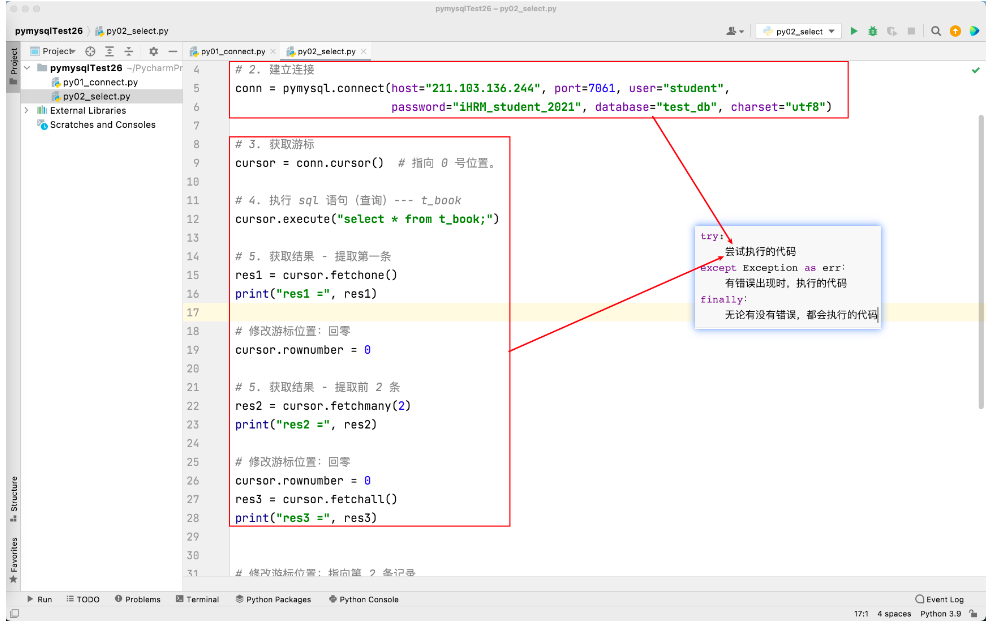
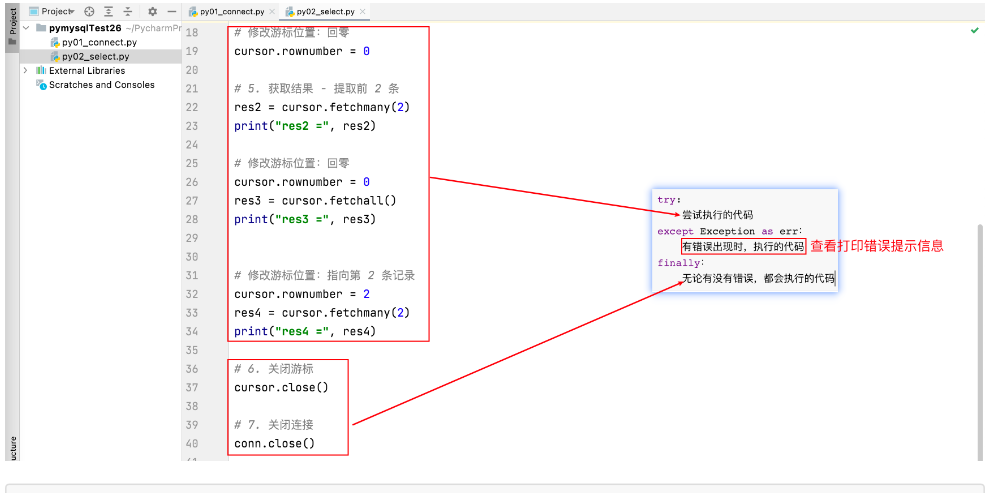
#1.导包
import pymysql
#定义全局变量,初始值为None
conn = None
cursor =None
try:
# 2.建立连接
conn = pymysql.connect(host="localhost", port=3306,
user="root", password="root",
database="test_db", charset="utf8")
# 3.获取游标
cursor = conn.cursor() # 指向0号位置
# 4.执行sql语句(查询) ---t_book
cursor.execute("select * from t_book")
# 5.获取结果 -提取第一条
res1 = cursor.fetchone()
print("res1=", res1)
# 修改游标位置:回零
cursor.rownumber = 0
# 获取结果 -提取前两条
res2 = cursor.fetchmany(2)
print("res2=", res2)
# 修改游标位置:回零
cursor.rownumber = 0
# 获取结果 -获取全部数据
res3 = cursor.fetchall()
print("res3=", res3)
# 修改游标位置:指向第2条记录
cursor.rownumber = 2
# 获取结果 -提取第3条和第4条
res4 = cursor.fetchmany(2)
print("res4=", res4)
except Exception as err:
print("查询语句执行出错:",str(err))
finally:
# 6.关闭游标
cursor.close()
# 7.关闭连接
conn.close()
数据库UID
更新操作流程
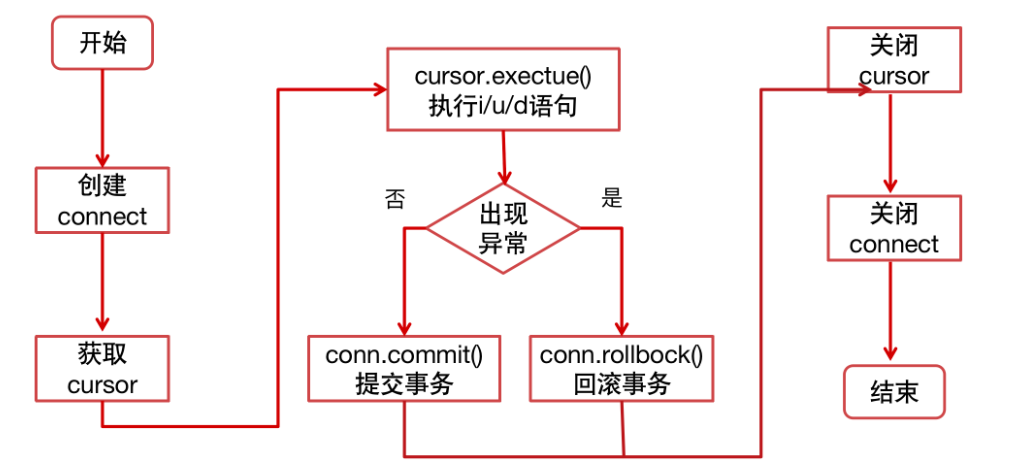
案例
单独实现如下操作:①:新增一条图书记录(id:5,title:西游记,pub_date:1986-01-01)②:把图书名称为西游记的阅读量加一 ③:删除名称为’‘西游记’'的图书
插入数据:
"""
新增一条图书记录(id:5,title:西游记,pub_date:1986-01-01)
insert into t_book(id,title,pub_date) values(5,'西游记','1986-01-01');
1.导包
2.创建连接
3.获取游标
4.执行insert语句
5.提交/回滚事务
6.关闭游标
7.关闭连接
"""
#1.导包
import pymysql
#定义全局变量,初始值为None
conn = None
cursor =None
try:
# 2.建立连接
conn = pymysql.connect(host="localhost", port=3306,
user="root", password="root",
database="test_db", charset="utf8")
# 3.获取游标
cursor = conn.cursor()
# 4.执行insert语句
cursor.execute("insert into t_book(id,title,pub_date) values(5,'西游记','1986-01-01');")
#查看sql执行,影响多少行
print("影响的行数:",conn.affected_rows())
#5.提交事务
conn.commit()
except Exception as err:
print("插入数据错误:",str(err))
#回滚事务
conn.rollback()
finally:
# 6.关闭游标
cursor.close()
# 7.关闭连接
conn.close()
修改数据:
"""
把图书名称为'西游记'的阅读量加一
update t_book set `read`=`read`+1 where id=5
1.导包
2.创建连接
3.获取游标
4.执行update语句
5.提交/回滚事务
6.关闭游标
7.关闭连接
"""
#1.导包
import pymysql
#定义全局变量,初始值为None
conn = None
cursor =None
try:
# 2.建立连接
conn = pymysql.connect(host="localhost", port=3306,
user="root", password="root",
database="test_db", charset="utf8")
# 3.获取游标
cursor = conn.cursor()
# 4.执行update语句.字段名,需要使用 反引号(`)包裹
cursor.execute("update t_book set `read`=`read`+1 where id=5")
#查看sql执行,影响多少行
print("影响的行数:",conn.affected_rows())
#5.提交事务
conn.commit()
except Exception as err:
print("更新失败:",str(err))
#回滚事务
conn.rollback()
finally:
# 6.关闭游标
cursor.close()
# 7.关闭连接
conn.close()
删除数据:
"""
删除名为'西游记'的图书
delete from t_book where title='西游记';
1.导包
2.创建连接
3.获取游标
4.执行update语句
5.提交/回滚事务
6.关闭游标
7.关闭连接
"""
#1.导包
import pymysql
#定义全局变量,初始值为None
conn = None
cursor =None
try:
# 2.建立连接
conn = pymysql.connect(host="localhost", port=3306,
user="root", password="root",
database="test_db", charset="utf8")
# 3.获取游标
cursor = conn.cursor()
# 4.执行delete语句
cursor.execute("delete from t_book where title='西游记';")
#查看sql执行,影响多少行
print("影响的行数:",conn.affected_rows())
#5.提交事务
conn.commit()
except Exception as err:
print("更新失败:",str(err))
#回滚事务
conn.rollback()
finally:
# 6.关闭游标
cursor.close()
# 7.关闭连接
conn.close()
数据库工具类封装
封装的目的
- 将常用的数据库操作,封装到一个方法。后续再操作数据库时,通过调用该方法来实现。
- 提高代码的复用性!
设计数据库工具类
#封装数据库工具类
class DButil(object):
@classmethod
def __get_conn(cls):
pass
@classmethod
def __close_conn(cls):
pass
#常用方法:查询第一条
@classmethod
def select_one(cls,sql):
pass
#常用方法:增删改
@classmethod
def uid_db(cls,sql):
pass
实现类方法
获取、关闭连接
#封装数据库工具类
import pymysql
class DBUtil(object):
#添加类属性
conn=None
@classmethod
def __get_conn(cls):
#判断conn是否为空,如果是,再创建
if cls.conn is None:
cls.conn=pymysql.connect(host="localhost", port=3306,
user="root", password="root",
database="test_db", charset="utf8")
#返回非空连接
return cls.conn
@classmethod
def __close_conn(cls):
#判断 conn不为空,需要关闭
if cls.conn is not None:
cls.conn.close()
cls.conn=None
查询一条记录
#封装数据库工具类
class DButil(object):
#常用方法:查询一条
@classmethod
def select_one(cls,sql):
cursor =None
res =None
try:
#获取连接
cls.conn=cls.__get_conn()
#获取游标
cursor=cls.conn.cursor()
#执行查询语句
cursor.execute(sql)
#提取一条结果
res=cursor.fetchone()
except Exception as err:
print("查询sql错误:",str(err))
finally:
# 6.关闭游标
cursor.close()
# 7.关闭连接
cls.__close_conn()
#将查询sql执行的结果 返回
return res
if __name__ == '__main__':
res=DButil.select_one("select * from t_book;")
print("查询结果为:",res)
增删改数据
# 封装数据库工具类
class DBUtil(object):
# 常用方法:增删改
@classmethod
def uid_db(cls, sql):
cursor = None
try:
# 获取连接
cls.conn = cls.__get_conn()
# 获取游标
cursor = cls.conn.cursor()
# 执行 uid 语句
cursor.execute(sql)
print("影响的行数:", cls.conn.affected_rows())
# 提交事务
cls.conn.commit()
except Exception as err:
# 回滚事务
cls.conn.rollback()
print("增删改 SQL 执行失败:", str(err))
finally:
# 关闭游标
cursor.close()
# 关闭连接
cls.__close_conn()
if __name__ == '__main__':
DBUtil.uid_db("update t_book set is_delete = 1 where id = 1111;")
完整封装代码实现
import pymysql
# 封装数据库工具类
class DBUtil(object):
# 添加类属性
conn = None
@classmethod
def __get_conn(cls):
# 判断 conn 是否为空,如果是,再创建
if cls.conn is None:
cls.conn = pymysql.connect(host="localhost", port=3306,
user="root", password="root",
database="test_db", charset="utf8")
# 返回 非空连接
return cls.conn
@classmethod
def __close_conn(cls):
# 判断,conn 不为空,需要关闭。
if cls.conn is not None:
cls.conn.close()
cls.conn = None
# 常用方法:查询一条
@classmethod
def select_one(cls, sql):
cursor = None
res = None
try:
# 获取连接
cls.conn = cls.__get_conn()
# 获取游标
cursor = cls.conn.cursor()
# 执行 查询语句
cursor.execute(sql)
# 提取一条结果
res = cursor.fetchone()
except Exception as err:
print("查询sql错误:", str(err))
finally:
# 关闭游标
cursor.close()
# 关闭连接
cls.__close_conn()
# 将查询sql执行的 结果,返回
# 常用方法:增删改
@classmethod
def uid_db(cls, sql):
cursor = None
try:
# 获取连接
cls.conn = cls.__get_conn()
# 获取游标
cursor = cls.conn.cursor()
# 执行 uid 语句
cursor.execute(sql)
print("影响的行数:", cls.conn.affected_rows())
# 提交事务
cls.conn.commit()
except Exception as err:
# 回滚事务
cls.conn.rollback()
print("增删改 SQL 执行失败:", str(err))
finally:
# 关闭游标
cursor.close()
# 关闭连接
cls.__close_conn()
if __name__ == '__main__':
res = DBUtil.select_one("select * from t_book;")
print("查询结果为:", res)
DBUtil.uid_db("update t_book set is_delete = 1 where id = 4;")























 被折叠的 条评论
为什么被折叠?
被折叠的 条评论
为什么被折叠?








